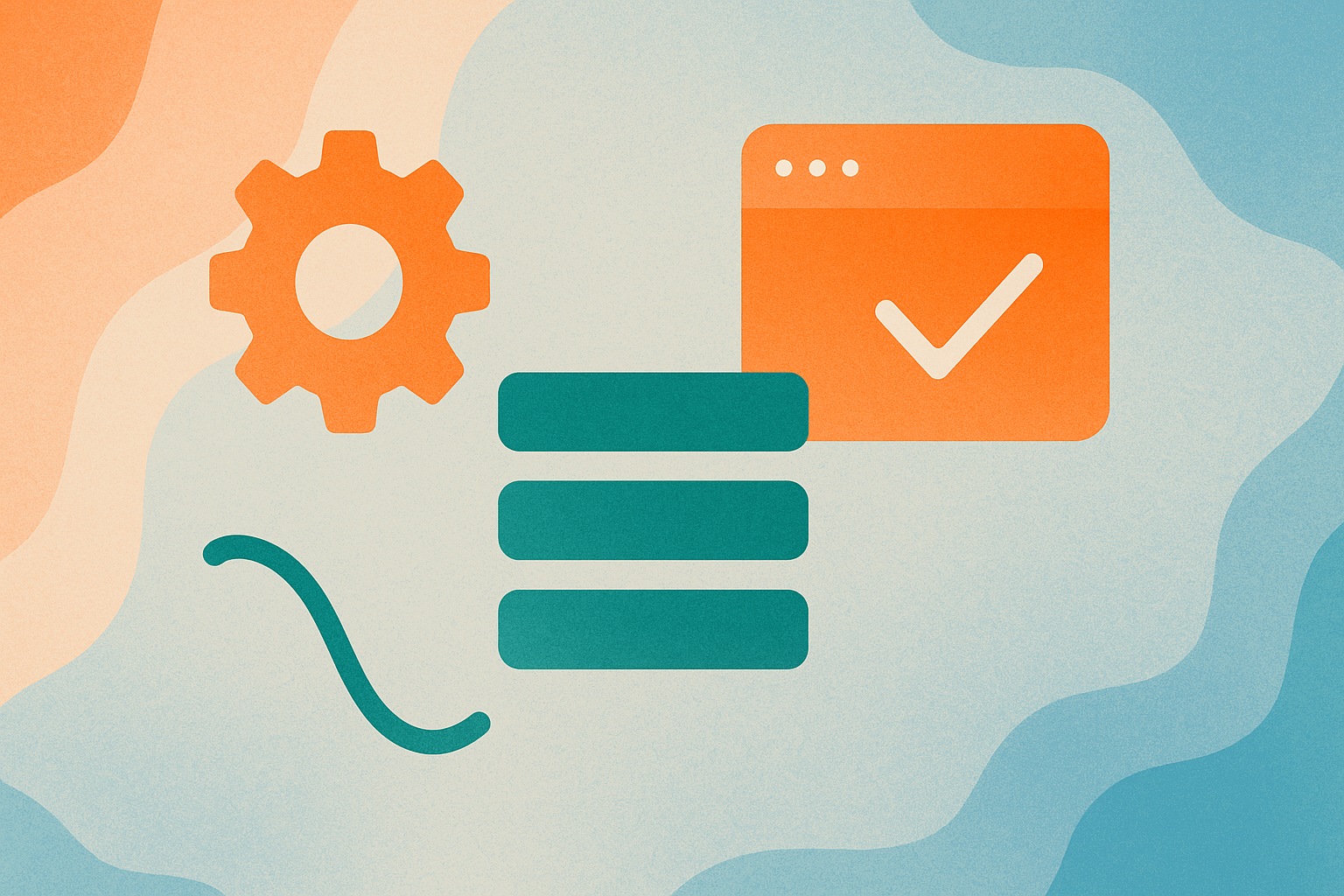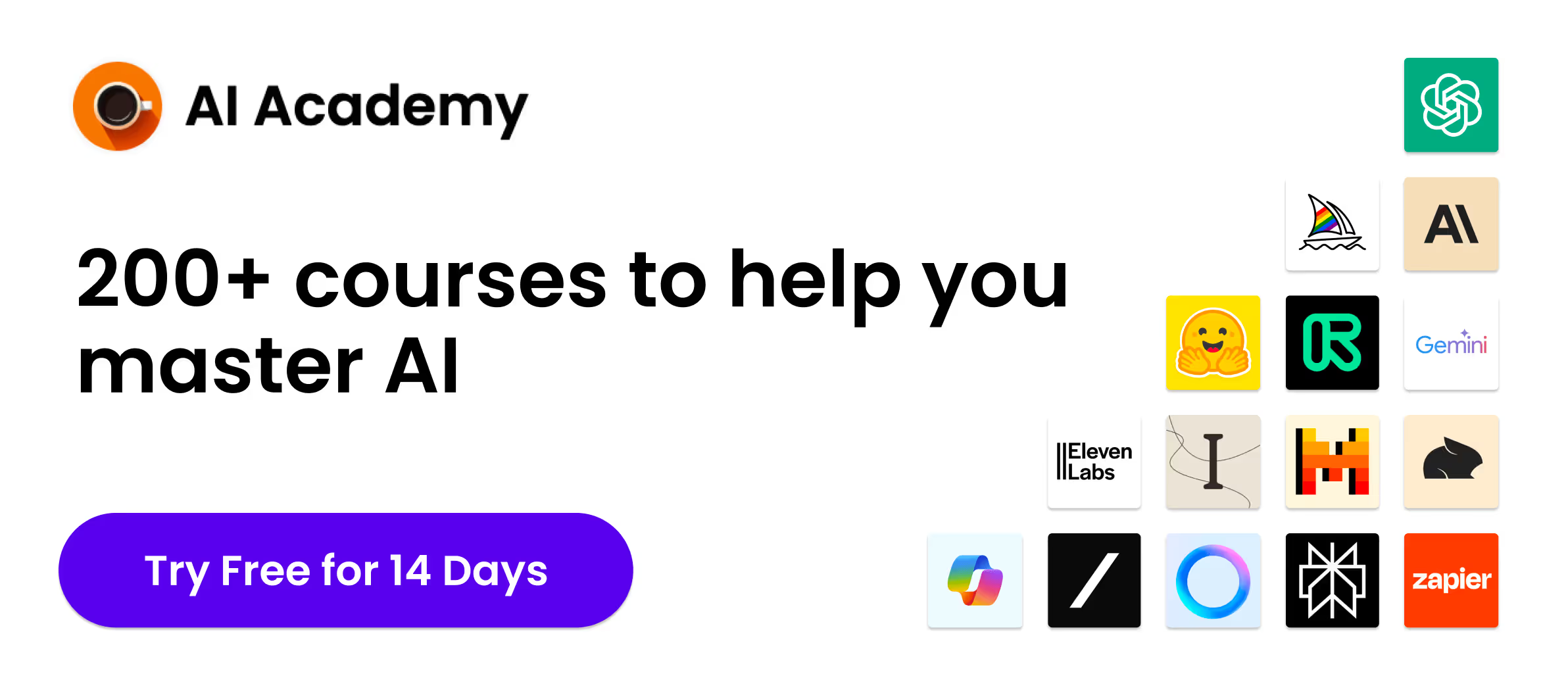HubSpot's customer platform eliminates workflow chaos through three core features: unified data management, intelligent automation, and centralized communication.
If you're drowning in spreadsheets, juggling multiple tools, and watching your team waste hours on repetitive tasks, you're not alone. Most businesses struggle with disconnected systems that make simple tasks unnecessarily complex. HubSpot's customer platform changes that completely, which is why 268,000+ companies have chosen it to streamline their operations.
Affiliate Disclosure: We may earn a commission from affiliate links in this review. However, all opinions are our own, and we only recommend products we believe in.
Here are three game-changing HubSpot features that actually deliver on their promise to simplify your workflow.
1. HubSpot's Unified Platform: Everything Lives in One Place (Finally)
You know that moment when a customer calls asking about their order, and you're frantically switching between your CRM, email, and order management system just to get basic information? Or when your sales team has no clue that marketing sent three targeted emails to a prospect last week?
Most businesses end up with a patchwork of tools that don't talk to each other. Your sales data lives in one place, marketing analytics in another, and customer service tickets in a completely different system. It's like trying to solve a puzzle when half the pieces are scattered across different rooms.
HubSpot's unified platform changes this dynamic completely. When a prospect opens an email, visits your pricing page, and then fills out a contact form, everything gets recorded in one timeline. Your sales rep can see that this person is clearly interested (they've visited pricing three times) before making the call.
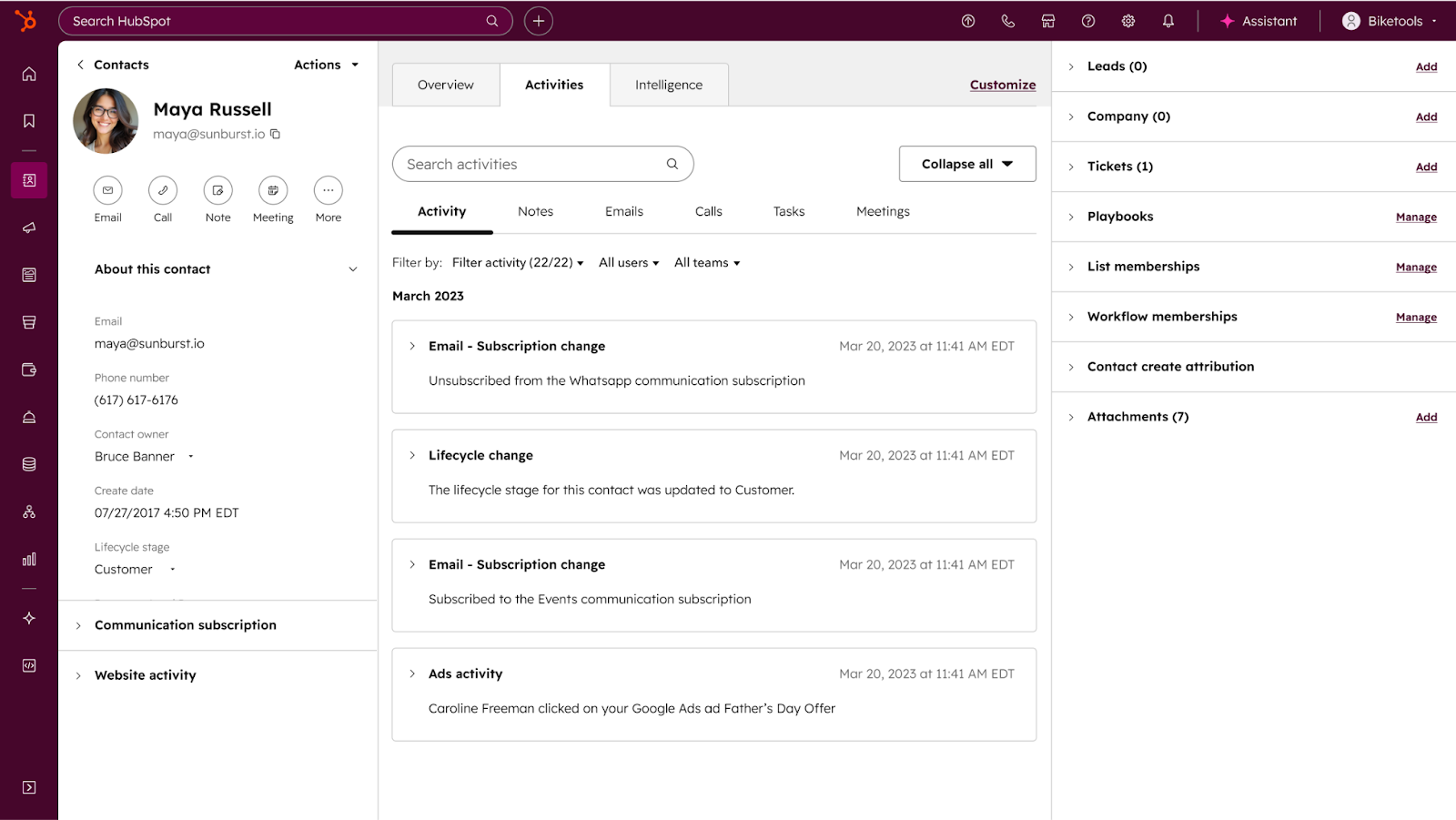
Aerotech, a manufacturing company, was losing deals because their sales team didn't know when prospects were actively browsing their pricing page. After implementing HubSpot, they set up alerts for high-intent behaviors. Result? They improved their win rate by 66% in just a few months simply because they could strike while the iron was hot.
Technical Capabilities
HubSpot's Smart CRM automatically captures:
- Website visits and page views
- Email opens and click-through rates
- Form submissions and content downloads
- Social media interactions and engagement
- Phone calls and meeting records
- Sales pipeline movement and deal updates
The setup process is remarkably simple. Import your contacts, connect your email, and HubSpot starts building that complete picture automatically. No complex integrations or IT involvement required.
HubSpot's free Smart CRM includes up to 1,000 contacts and 1 million records, deals and pipeline management, task automation, and email integration. The platform automatically captures website visits, email opens, and form submissions, creating a complete timeline of every customer interaction.
Get started with HubSpot free – it's actually free, not "free trial with hidden catches" free.
2. HubSpot Automation: Let AI Save You Time
Let's be honest about something: most "automation" tools aren't that helpful. They either require a computer science degree to set up, or they're so basic they barely save any time. HubSpot's automation sits in a different category entirely – intelligent enough to handle complex scenarios, simple enough for non-technical users.
The average sales rep spends 14 hours per week on admin tasks. That's nearly two full workdays of copying contact information, updating spreadsheets, and sending follow-up emails.
HubSpot workflow automation eliminates this by triggering actions based on behavior:
- Someone downloads your pricing guide? Automatically add them to a nurture sequence
- Lead visits pricing page three times? Instantly notify the assigned sales rep
- Deal sits unchanged for a week? Automatically escalate to the manager
- New customer signs up? Immediately create onboarding tasks
Real customers have seen tremendous time savings after implementing HubSpot. For example, HubSpot enabled Agicap (B2B software company) to build a workflow that scores leads based on behavior, assigns them to reps, and sends personalized emails within 5 minutes. Instead of taking 48 hours to respond to leads, now they save 750 hours per week and see 20% faster deal velocity.
AI-Powered Personalization
HubSpot's workflow automation requires a paid subscription to unlock its full potential. While the free version offers basic pipeline automation (moving deals between stages), advanced workflows like automatic email sequences and lead scoring are available with Professional and Enterprise plans.
Workflow creation in HubSpot works through a visual editor:
- Set triggers based on specific actions (form submissions, page visits, email opens)
- Add delays between actions to time your outreach perfectly
- Create decision branches that personalize the experience based on contact information
- Connect with 1,800+ other tools for seamless data flow
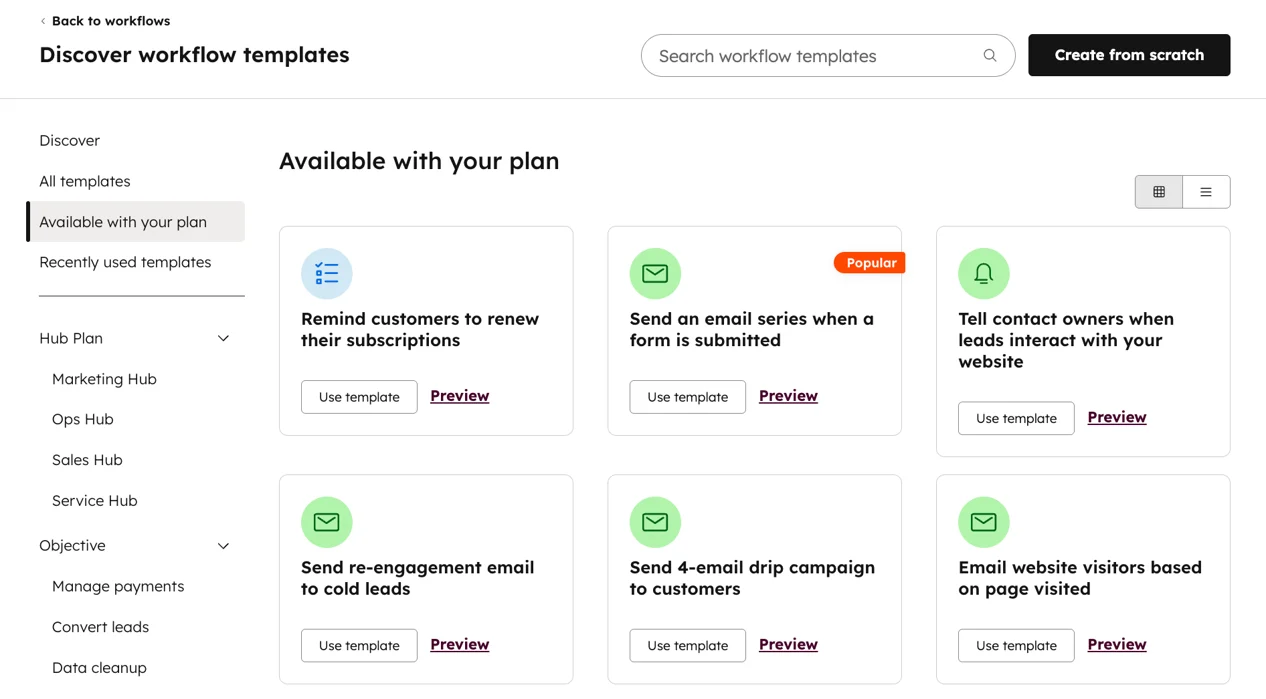
The setup process is surprisingly straightforward. Start with one core workflow (maybe a welcome email for new subscribers) and build from there.
For teams not ready for paid automation, HubSpot's free AI tools offer a middle ground between manual processes and full workflow automation.
One of the most practical of these is the AI email writer, which helps create professional email templates without requiring workflow automation.
HubSpot's AI email writer generates complete email drafts using natural language processing and your CRM data for personalization. Rather than basic templates, the AI understands context, tone, and intent to create emails that feel natural and authentic.
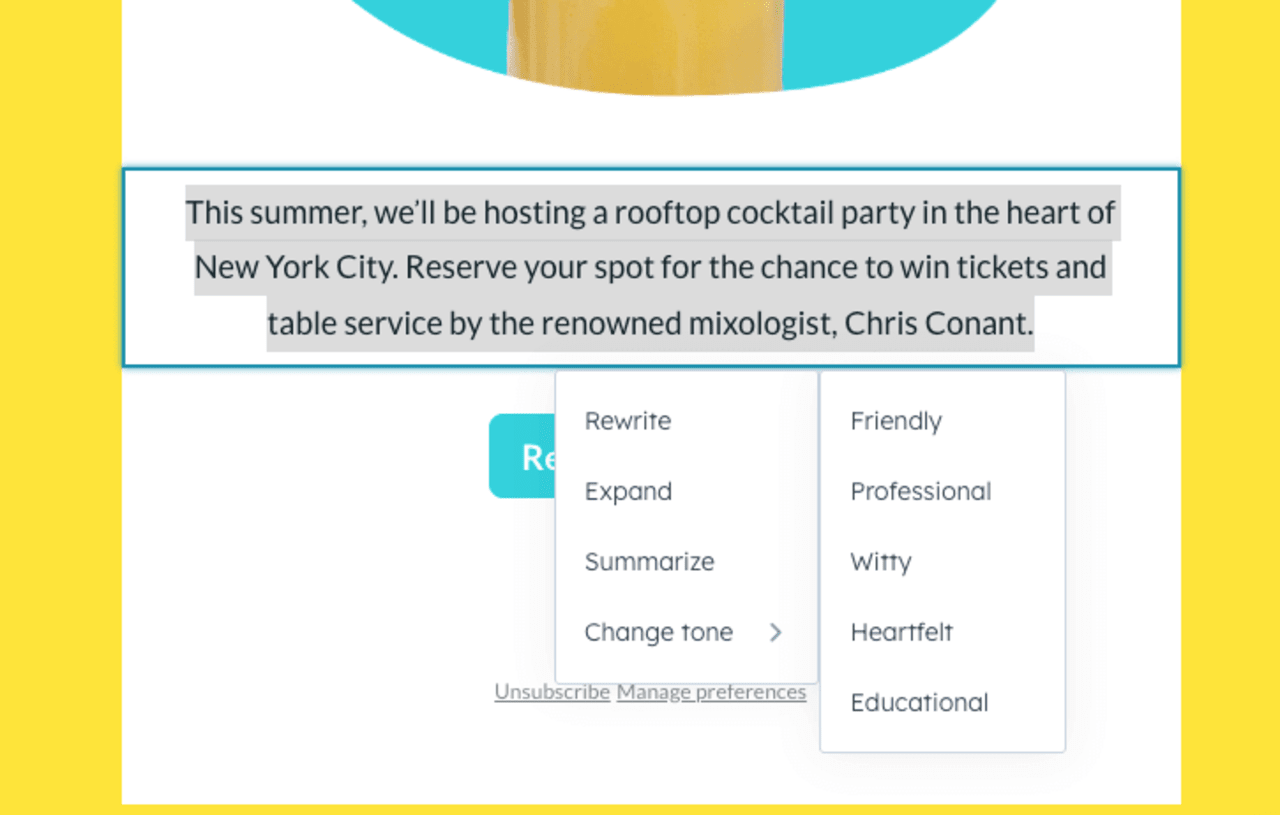
Specific capabilities include:
- Slash and highlight commands to edit length, spelling, and tone of generated content
- Automatic CTA generation that fits your brand and message intent
- Multiple draft variations allowing you to choose the most effective message
- HubSpot CRM integration that pulls contact details, company information, and interaction history for personalization
You can input prompts up to 4,000 characters describing your email goal, and HubSpot will generate complete drafts including subject lines and body copy. The tool can also adjust messaging based on recipient role (decision-maker vs. influencer) and company data stored in your HubSpot CRM.
3. HubSpot's Multi-Channel Communication Hub: One Inbox for Everything (Yes, Everything)
Here's a scenario that might sound familiar: It's 2 PM on a Wednesday. Sarah from accounting emails you about an invoice question. While you're digging through your email, she also sends a Facebook message because she didn't hear back quickly enough. Then she fills out the contact form on your website with the same question, just in case.
In most business setups, that's three separate conversations happening in three different places. Your email team sees one version, your social media person sees another, and whoever monitors the website forms sees the third. Nobody has the complete picture, and Sarah gets increasingly frustrated as she repeats herself.
HubSpot's conversation inbox eliminates this by consolidating every channel into one location.
The unified conversations inbox handles:
- Team email addresses and shared aliases
- Live chat from your website
- Facebook Messenger conversations
- WhatsApp Business messages (Professional/Enterprise)
- Form submissions that require follow-up
- Custom channels through API integrations
Conversation routing rules ensure messages reach the right team member automatically. Set up round-robin assignment, route based on inquiry type, or assign conversations to contact owners. The system tracks response times and conversation resolution, so you can identify where things are slowing down.
The setup process is refreshingly straightforward. Connect your channels (most take just a few clicks), set your routing preferences, and you're operational. No complex configuration or months-long implementation process.
Cold Jet implemented HubSpot to replace their legacy CRM system. By unifying their data management and enabling mobile functionality for their sales team, they cut lead response time by 66% (from 3 hours to under 1 hour). The unified platform improved internal coordination and eliminated manual data entry errors.
What's particularly useful is the mobile app functionality. This isn't some watered-down mobile version. HubSpot’s mobile app gives you full CRM access wherever you are with connection. You can update deals from the airport or on the go between two different meeting locations.
Getting Started with HubSpot Without the Headaches
Many solutions promise easy setup but deliver months-long implementations. HubSpot's different because it's designed for all teams, not just IT departments.
You're probably not going to have everything perfectly optimized on day one. That's normal. What you can expect is to have basic functionality working within a week, and to gradually add customization as your team gets comfortable.
Week 1: Basic Setup
- Create your HubSpot account in 2 minutes using your email address or Google/Apple login. HubSpot automatically provides a fallback email address and creates your default conversations inbox during the signup process.
- Import your contacts. This can be trickier depending on how messy your current data is, but HubSpot handles most formatting issues automatically and supports CSV uploads. The free version can process up to 1,000 contacts and suggests field mapping for common data types.
- Connect your email immediately for Gmail and Office 365 users through native integrations. Configure other email providers through manual IMAP setup that typically completes within minutes
- Configure basic CRM settings in 1 hour. Customize your sales pipeline stages, set up deal probability percentages, and configure user permissions for team members.
Week 2: Marketing Foundation
- Create email templates with AI assistance. HubSpot's free version includes AI-powered email generation for sales outreach and marketing campaigns. Build reusable templates your team can customize to save time on every day tasks.
- Design lead-capture forms without coding to convert website visitors into qualified leads. HubSpot’s forms tool automatically creates contact records and syncs with your CRM database.
- Build landing pages that generate leads using HubSpot's free page builder. You won’t need designers or developers and you can choose from templates and customize for your business.
Week 3: Add Channels
- Install the browser extension for Gmail/Outlook to access CRM functionality directly within your inbox. Log emails, create contacts, and track interactions without switching tools. You can also set up email tracking to get notified when prospects open your emails. HubSpot helps you turn email opens into perfectly timed follow-ups to convert more leads into deals.
- Add live chat to your website with HubSpot's free chat widget. Connect with website visitors in real time to convert leads and provide customer support.
- Set up meeting scheduling links that sync with Google Calendar or Office 365. Book more sales meetings with less back-and-forth - prospects pick times that work for them
Week 4: Team Training
- Complete free CRM training courses at HubSpot Academy covering contact management, email marketing, deal tracking, pipeline visualization, and more.
- Join HubSpot Community forums with 100,000+ members to get tips on maximizing the platform’s features. Search knowledge base for specific questions about each tool’s capabilities.
- Integrate external AI tools with your CRM. Connect ChatGPT and Claude to enhance your HubSpot workflows.
The real timeline looks more like this: useful within days, comfortable within weeks, wondering how you lived without it within months. Not because HubSpot is magical, but because it eliminates a lot of the small, daily frustrations that add up over time.
Why Teams Choose HubSpot Over Alternative CRMs
The CRM market is crowded, and honestly, most platforms can handle basic contact management and deal tracking. The differences show up in day-to-day usability and how much technical expertise you need to get things working.
Salesforce excels at complex, multi-department implementations with dedicated IT resources. It can do almost anything, which is both its strength and its weakness. Need to track complex multi-touch attribution across 15 different marketing channels? Salesforce can handle it. Want to send a simple follow-up email when someone downloads your white paper? You'll need a developer, a consultant, and about three weeks of implementation time. With HubSpot, simple tasks stay simple, complex features remain accessible. For most businesses, that's a better trade-off.
Zoho offers a comprehensive suite of business applications at attractive prices. In theory, having everything from CRM to project management to accounting in one ecosystem sounds great. In practice, you'll discover that "integrated" doesn't always mean "works well together." Data doesn't sync cleanly between modules, the user interface feels inconsistent across different tools, and getting help requires figuring out which product team handles your specific issue.
Monday.com excels at visual project management and team collaboration. If your business revolves around project-based work, it might be a better fit than a traditional CRM. But if your revenue comes from ongoing customer relationships rather than discrete projects, you'll find yourself trying to force CRM functionality into a project management framework.
The choice usually comes down to your team's technical comfort level and what type of growth you're planning. If you have dedicated IT resources and complex requirements, Salesforce might be worth the complexity. If you want to spend time on your business rather than managing your software, HubSpot probably makes more sense.
Frequently Asked Questions
Is HubSpot's free CRM actually useful for small businesses?
Yes, HubSpot's free CRM is genuinely useful for small businesses, but with realistic expectations. You get up to 2 users and 1,000 contacts, full CRM functionality, and basic automation. Where you'll bump into limitations is advanced reporting, sophisticated automation, and removing HubSpot branding from customer-facing emails.
Many small businesses use the free version for 6-12 months before upgrading, not because they're required to, but because HubSpot scales alongside their growth – turning on more powerful features as their business needs evolve.
How long does it take to see workflow improvements with HubSpot's customer platform?
You'll probably notice efficiency improvements within a couple weeks as your team gets familiar with having everything in one place. Revenue impact takes longer—typically 2-3 months—as your improved processes start affecting your actual sales cycle. This isn't because HubSpot is slow to work, but because sales cycles take time to complete.
What happens when my business outgrows HubSpot's free features?
You won’t outgrow HubSpot, it scales pretty extensively. They have customers ranging from two-person startups to large enterprises. The bigger question is whether you'll want to pay for enterprise-level features. The pricing can get steep at higher tiers.
How secure is my customer data in HubSpot?
HubSpot implements enterprise-level security measures to protect your customer information across Amazon Web Services and Google Cloud infrastructure. Your data is automatically replicated to three separate data centers with comprehensive hourly and daily backups, ensuring availability even during server failures.
All communications use advanced TLS encryption with 2048-bit security keys, while stored data is encrypted at rest for additional protection. You can enable two-factor authentication for enhanced login security, and HubSpot's internal systems communicate through secure Virtual Private Networks.
This multi-layered approach provides the same security standards used by major financial institutions and government agencies. The security is solid, probably better than most internal IT setups. But if you're in a highly regulated industry with specific compliance requirements, you'll want to review their compliance documentation directly rather than taking anyone's word for it.
What support resources are available for HubSpot CRM users?
HubSpot’s support quality varies significantly by what you're paying. Free users get knowledge base and community forums (which are actually pretty good). Paid plans include email and chat support. Phone support is reserved for Professional and Enterprise subscribers. Response times average under one business day for most inquiries, though complex technical issues can take longer.
Stop Reading, Start Doing
Three features. That's all we covered. HubSpot has hundreds more, but these three will transform how your team works:
- Unified data that actually makes sense
- Automation that saves real time
- Communication tools that customers love
Your competition is probably still copying and pasting between spreadsheets while you're reading this.
Start your free HubSpot account and give your team the tools they've been asking for. No credit card required. No sneaky trials. Just better workflows starting today.
Still skeptical? Fair enough. But what if we're right? What if you could actually simplify your workflow instead of just talking about it in meetings?
Find out for yourself. Your future self will thank you.
